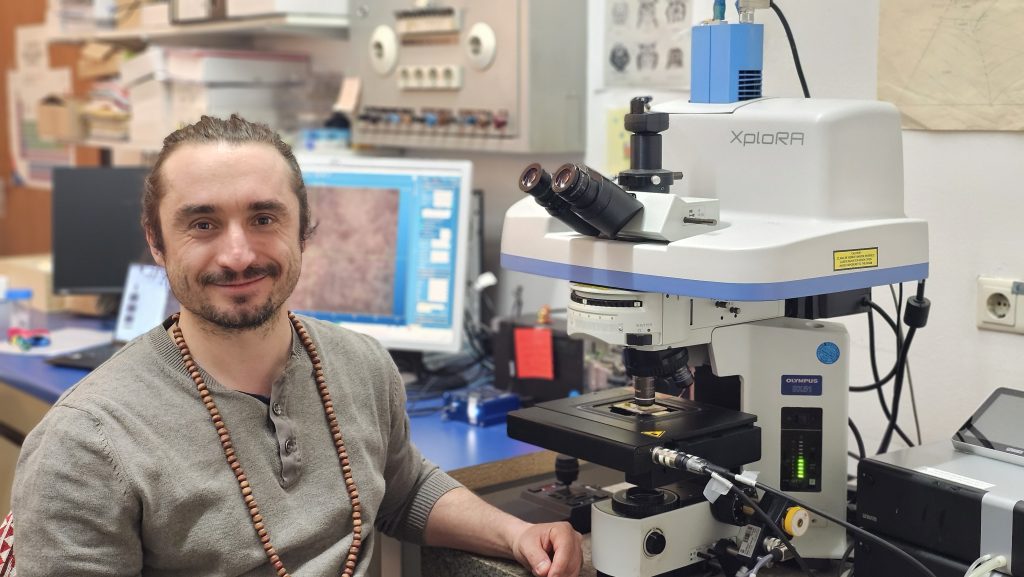PostDoc Researcher, ERC DiverseNile Project (until Aug. 2025)
Fabian.Dellefant@lmu.de

Fabian Dellefant completed a PhD at the Department of Earth and Environmental Sciences at the Ludwigs-Maximilians-Universität Munich focusing on shock effects of Fe-Ti-oxides generated by meteorite impacts, which can contribute to km-scale magnetic anomalies. In his work, the application of Raman spectroscopy plays a central role, which he now utilizes to investigate maximum firing temperatures of archaeological ceramic samples in the framework of the DiverseNile project. Fabian possesses extensive experience in characterizing materials from various perspectives, including (magneto-)mineralogy, crystallography, and geology. He intends to leverage this expertise in investigating the petrography and potential provenance of Egyptian sandstone building materials.
Main Areas of Research
Characterization of geomaterials, Raman spectroscopy of charcoal, Archaeometry, Impact geology, (Magneto-)Mineralogy, Petrography
Methods
Optical microscopy (transmitted and reflected light); Raman spectroscopy; Scanning electron microscopy (+electron backscattered diffraction)
Education
01/2020 – 01/2024 Ludwig-Maximilians-Universität Munich
• PhD in the field of impact geology
10/2016 – 03/2019 Ludwig-Maximilians-Universität Munich & Technical University of Munich
• Course: MSc Geomaterials and Geochemistry
09/2013 – 03/2016 Ludwig-Maximilians-Universität Munich & Technical University of Munich
• Course: BSc Geosciences (focus on Mineralogy)
10/2012 – 09/2013 Ruhr-Universität Bochum
• Course: BSc Geosciences
Publications
Brückner L. M., Dellefant F., and Trepmann C. A. (2024) Quartz cleavage fracturing and subsequent recrystallization along the damage zone recording fast stress unloading. Journal of Structural Geology 178:105008. https://doi.org/10.1016/j.jsg.2023.105008.
Dellefant, F., Trepmann, C.A., Gilder, S.A., Sleptsova, I. V, Kaliwoda, M., and Weiss, B.P.(2022) Ilmenite and magnetite microfabrics in shocked gneisses from the Vredefort impact structure, South Africa. Contributions to Mineralogy and Petrology, 5. https://doi.org/10.1007/s00410-022-01950-5
Dellefant, F., Trepmann, C.A., Schmahl, W.W., Gilder, S.A., Sleptsova, I. V., and Kaliwoda, M. (accepted) Ilmenite phase transformations in suevite from the Ries impact structure (Germany) record evolution in pressure, temperature, and oxygen fugacity conditions. American Mineralogist. https://doi.org/10.2138/am-2023-8985
Dellefant F., D’Ercole G., Budka J., and Kaliwoda M. (2023) Differentiation of Late Bronze Age Nubian- and Egyptian-style ceramics from northern Sudan by manufacturing firing temperatures using Raman Spectroscopy. Journal of Archaeological Science: Reports 52:104233. https://doi.org/10.1016/j.jasrep.2023.104233.
Dellefant, F., Seybold, L., Trepmann, C.A., Gilder, S.A., Sleptsova, I. V., Hölzl, S., and Kaliwoda, M. (accepted) Emplacement of shocked basement clasts during crater excavation in the Ries impact structure. International Journal of Earth Sciences.
Seybold, L., Trepmann, C.A., Hölzl, S., Pollok, K., Langenhorst, F., Dellefant, F., and Kaliwoda, M. (2023) Twinned calcite as an indicator of high differential stresses and low shock pressure conditions during impact cratering. Meteoritics & Planetary Science, 19. doi.org/10.1111/maps.14056
Sleptsova I. V., Gilder S. A., Dellefant F., Trepmann C. A., Ahanin N., and Pohl J. (2024). Thermal and Structural History of Impact Ejecta Deposits, Ries Impact Structure, Germany. Journal of Geophysical Research: Solid Earth 129:1–23. https://agupubs.onlinelibrary.wiley.com/doi/10.1029/2023JB027460.
Trepmann, C.A., Dellefant, F., Kaliwoda, M., Hess, K.U., Schmahl, W.W., and Hölzl, S. (2020) Quartz and cristobalite ballen in impact melt rocks from the Ries impact structure, Germany, formed by dehydration of shock-generated amorphous phases. Meteoritics and Planetary Science, 55, 2360–2374. https://doi.org/10.1111/maps.13590
